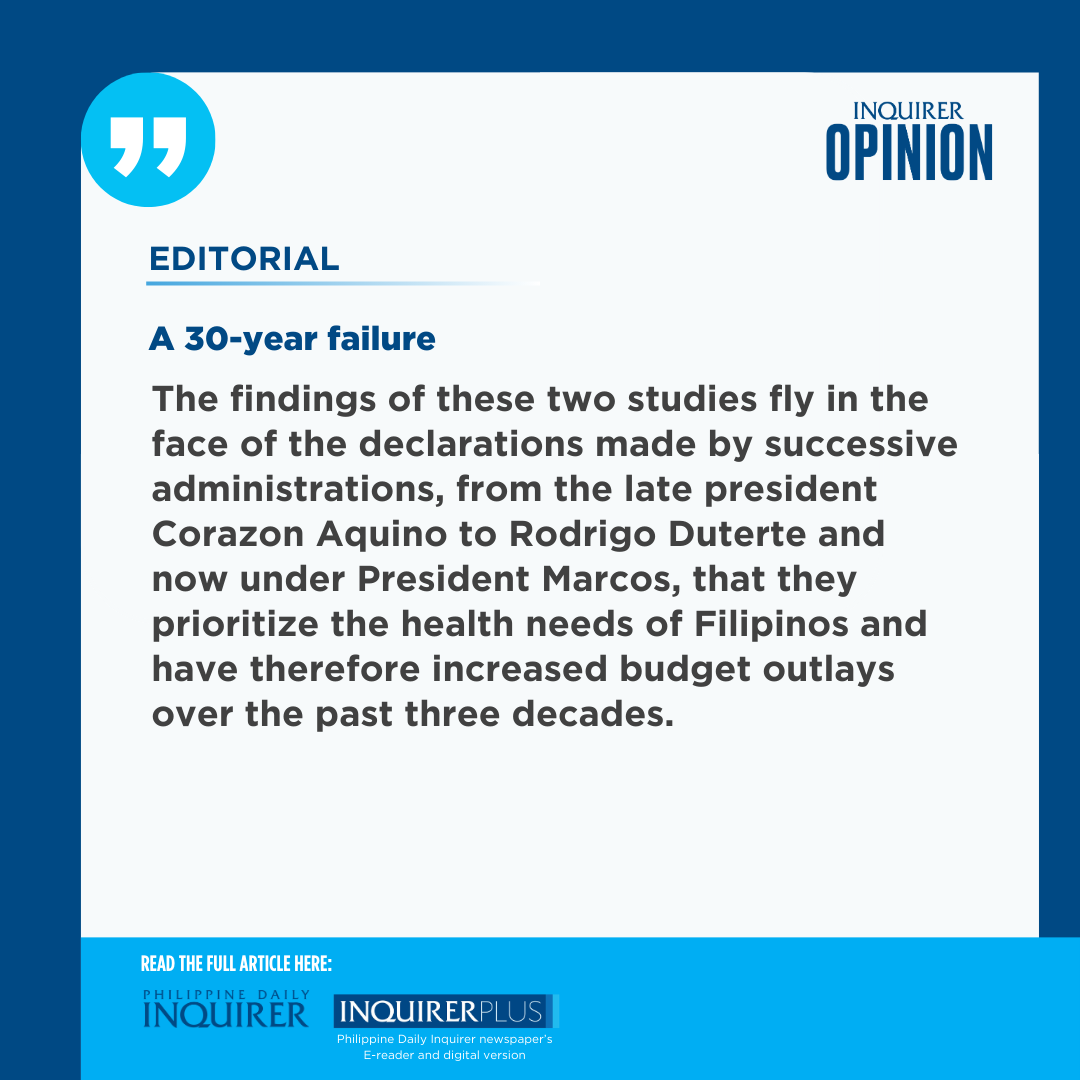A 30-year failure
Going by the absolute numbers alone, the growth in the Philippines’ total expenses on health over the past 30 years has been more than impressive, ballooning from P40.3 billion in 1991 to a whopping P1.1 trillion in 2022, for an average yearly increase of 10.95 percent.
But a further dissection of the Philippine health sector’s performance reveals a troubling state of affairs that demands urgent reforms. Indeed, after correcting the numbers for inflation and considering the near-doubling of the Philippine population over that period, health spending actually rose by just 3.9 percent a year. Worse, the single biggest portion of total health expenditure (THE) over the past 30 years came from Filipinos’ own wallets, despite the billions annually poured into the public health sector.
Article continues after this advertisementThese were among the disturbing findings of the groundbreaking study on the Philippine National Health Accounts from 1991 to 2022 conducted by professor Orville Solon, former dean of the University of the Philippines Diliman-School of Economics; former professor Alejandro Herrin, also of UPD-SE; and Dr. Michael Mo. “Out-of-pocket payments from households have been the biggest contributor to health-care spending ever since records started in 1991,” Mo underscored during the recent presentation of the research paper released by health think tank Unilab Center for Health Policy, a program of Unilab Foundation.
Heaviest burden
For instance, of the P1.12 trillion in health expenditures in 2022, P502 billion or 45 percent came from Filipinos’ pockets, equivalent to P4.50 for every P10, more than double the 20-percent limit on out-of-pocket spending set under the Health Sector Reform Agenda (HSRA) issued back in 1999.
In contrast, the national government contributed in 2022 just P234 billion (21 percent), local government, P109 billion (10 percent), while the Philippine Health Insurance Corp. (PhilHealth) accounted for just P153 billion or 14 percent of the total expenditures, thus falling far short of its mandate “to provide health insurance coverage and ensure affordable, acceptable, available, and accessible health-care services for all citizens of the Philippines.”
Article continues after this advertisementThe balance was shouldered by private insurance companies, including health maintenance organizations, which are far out of reach of the poor who need the government benefits the most but end up bearing the heaviest burden.
The paper’s findings complement similar results yielded by a 2023 discussion paper of state think tank Philippine Institute for Development Studies that said that the elderly, women, rural, and poorer Filipinos are more likely to pay out-of-pocket health-care costs that are “expected to increase for the entire population” in the coming years.
Health expenditures
The findings of these two studies fly in the face of the declarations made by successive administrations, from the late president Corazon Aquino to Rodrigo Duterte and now under President Marcos, that they prioritize the health needs of Filipinos and have therefore increased budget outlays over the past three decades.
As the researchers revealed in their study, which for the first time analyzed data collected annually from 1991 to 2022, the share of public health spending to THE “has not significantly increased over the past 30 years.”
Particularly troubling is the finding that the local government units that are at the frontline of public service and entrusted with a bigger responsibility to deliver health services under the Local Government Code of 1991 have not been contributing as much as they should to health expenditures.
Instead, what increased was the share—from 44 percent to 52 percent—borne by Filipino citizens who are counting on the government to shell out the bigger portion considering their regular contributions to PhilHealth.
Groundbreaking study
As Mo stressed, the targets under the HSRA were for national and local government spending to reach 40 percent of THE and for social health insurance, particularly PhilHealth, to account for 30 percent of the total spend—and not just 14 percent as seen in 2022—thus easing the burden on Filipinos.
Fortunately, Mr. Marcos has taken the right steps with his commitment in his July State of the Nation Address for increased benefits for stroke, pneumonia, and common cancers while PhilHealth has also increased its benefits package for the first time since 2013 this year.
Preliminary data from the Philippine Statistics Authority also showed that in 2023, out-of-pocket expenses went down slightly to 44.4 percent from 44.7 percent in 2022.
If the Marcos administration takes the groundbreaking study to heart and spends better and more for the health needs of the poor, it will have the distinction of having done what governments in the past three decades have failed to do.
















